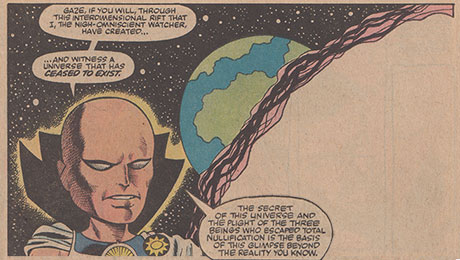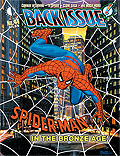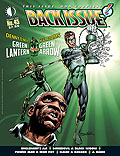Stan Lee/Jack Kirby
Contains part or all of Fantastic Four #s 36, 38, 41-48, 50,52,54-65, Annual #5, Thor #146-152, Not Brand Ecch #6
Karen: The Inhumans have a long and complicated history in the Marvel universe. They've mostly served as supporting players and guest stars, occasionally getting a shot at their own book. Currently they've become more prominent as real world business concerns have pushed them to the forefront, as they essentially have usurped the role that mutants once held as the super-powered outcasts hiding among normal human beings. They've also become key figures on Marvel's Agents of SHIELD TV show, although none of the established comics characters have appeared. But they started out very differently, as members of a mysterious hidden race of people with ancient origins. Marvel has put together a nice TPB called The Origin of the Inhumans that takes issues and partial issues from different sources to tell the story of the Inhumans. If you don't like books where you only get part of an issue, then this isn't the TPB for you. However, in my case, I had the FF issues already. I was most interested in the Thor back-ups found here. And, I just wanted everything in one place. This is less a review of the book than a discussion of the piecemeal origin story of the Inhumans.
Karen: Their first appearances came in the pages of Fantastic Four, where readers were as puzzled by the strange group as the FF themselves. "Are they mutants?" Sue Richards asked her husband Reed Richards upon their first encounter in FF #46 (January 1966). "No, Sue! They seem to think of themselves as Inhumans - and they may be right!" Later, Reed states that, "I realize now that they are a slightly different type of life which evolved without mankind knowing it...and they've combined all their inhuman powers for their mutual safety!" Sue surmises, "Then Medusa wasn't some sort of freak, but rather part of some strange unsuspected race!"
Karen: This was basically all we knew about the beginnings of the Inhumans until almost a year and a half later, when the details of how they developed so far past the rest of humanity were revealed in an unlikely place: the back pages of Thor. Previously, the Thunder God's mag had featured Tales of Asgard as a back-up feature, and this seemed fitting; but out of nowhere, starting with issue #146, cover dated November 1967, the Inhumans took over the back up spot for seven issues. The first two stories dealt directly with how the Inhumans came to be; the next two tales revealed Blackbolt's origin; and the final three stories were simply a Triton solo adventure. (For the curious, after those seven stories, the decision was made to devote the entire book to the Thunder God, and not long after, the Inhumans popped up in Amazing Adventures, splitting that book with the Black Widow). The initial tale "The Origin of ...The Incomparable Inhumans!" reiterates what The Seeker had said previously: that his people had advanced beyond humanity far back in time, when mankind was just beginning to develop tools and language. But expanding on this, we are shown the homeland of the Inhumans, the island of Attilan, a technological marvel. The people here are dedicated to knowledge -both the story and visuals here cannot help but conjure up thoughts of the legends of Atlantis. The leading scientists have made a new discovery -Terrogen Mist. At this point, the Inhumans are not Inhuman -they are advanced, yes, but have no special powers. Randac, their leader, muses that the Terrogen Mist "...might unleash a deadly plague upon the Earth! But its mysterious power might also erase the natural, basic weaknesses in man -- allowing us to become more than human--allowing us to advance a step beyond Homo sapiens..." Randac decides he will test the Mist on himself, and in doing so, becomes the first ancestor of the Inhumans.
Karen: If this origin story sounds familiar to you, it may be because you've read Chariots of the Gods or just watched a lot of the History Channel. It's essentially the 'Ancient Astronauts' theory, and it's been around a very long time. It's been a staple of science fiction stories in print and TV and film. The Inhumans' origin mashes together the ancient astronaut legend with Hidden Race stories, like Hollow Earth tales, the Shaver mysteries, and so on. Blackbolt and company were provided with a solid science fiction lineage that gave them strong roots in the Marvel universe - part of the FF's supporting cast, born of both Earth and the cosmos, they could fit into any sort of story that Lee/Kirby could contrive.
Karen: Blackbolt himself received the spotlight in the next two Thor back-up issues (Thor #s 148 and 149, Jan-Feb 1968), as the silent king's birth and youth were explored. Born to Agon and Rynda, the chief geneticists of Attilan, Blackbolt is shown exhibiting powers as an infant -no Terrigen Mist is mentioned here. In this sense, he seems more like a mutant than an inhuman. He has control over electrons -which seems to allow him to manipulate both matter and energy. The babe creates toys for himself from thin air, although we are told this power will fade as he grows older. Other powers, such as levitation, will, however, grow stronger. Unanticipated, though, is the newborn's sonic scream, which decimates the building he is in and several others, although he is unharmed, due to a force shield he constructed subconsciously.
Karen: Kirby obviously had a fascination with the ancient astronaut theory. He used it again when he returned to Marvel in the 1970s and created The Eternals, who resemble the Inhumans in that they are the super-powered products of alien 'seeding' of Earth, and live apart from mankind. But they are different too, in that they were initially meant to be outside of regular Marvel continuity and were supposed to be the source of mankind's many mythologies. But the Eternals got scooped up into the mainstream Marvel universe and then the two groups with their similar backgrounds had to be reconciled, which of course they were, despite all the convolutions this involved.
Karen: Re-reading the Inhumans' initial introduction into the Marvel universe in the 1960s pages of the Fantastic Four was a distinct pleasure. Of course, the FF at this time was truly "the world's greatest comic magazine" - a perfect example of two creators at the pinnacle of their abilities. Each issue provided another tantalizing detail, another glimpse into an amazing unseen world of possibilities. I can only imagine how exciting it must have been to have read these issues as they first appeared! But even today, the story of the Inhumans is well worth the effort of discovery.



























































9 comments:
Is the Sentry explaining his mission on Earth to that mammoth?
Because that what it looks like, just sayin'.
M.P.
Well, M.P., maybe it's the talking mammoth from Ice Age who sounds just like Ray Romano... :P
Karen, thanks for the review and the tip on this book. I recall reading a bunch of these Inhumans origin stories in the early 1980s - they were reprinted in Marvel Tales, I think. There was also a new (i.e., non-reprint) Inhumans back-up story in an issue of What If - of all places - which tells how they moved Attilan to the Himalayas with the help of the Eternals.
I found all of these stories quite interesting. You're right about the great world-building that was going on there, and I think it's a bit unfortunate that all of the attempts to have the Inhumans run as a solo feature never really gained traction and led to a long-term ongoing series. The concept and characters are quite good.
Weren't the Thor back ups repurposed material from a Lee/Kirby Inhumans comic? I loved seeing them in the FF but they could never sustain a title; they only work when contrasted with humans. Also, reformed Medusa was a shadow of herself. She was far more effective as a villain.
Nice writeup on the Inhumans. Like the others, I always enjoyed seeing them as guest stars when interacted with the FF and Avengers. But every "Inhumans" story seemed to lead to Maximus going insane and doing something evil again.
I always wondered how much ahead Kirby had his worlds thought out. I agree that Medusa was probably not developed with the Inhumans in mind, but I wonder when his creativity linked the two. Were there many early Marvel villains that the origin was skipped over and left for further explanation? Green Goblin was left mysterious in Spider Man. But I find it interesting Medusa was as well. I must just be forgetting others. Although with less than a year separating Medusa's and Inhumans' intros, it makes me curious.
I like the Inhumans, always have. They were supposed to be strange and genuinely came across that way. I also like that historically they weren't over used, so it was nice to see them very occasionally. I have fond memories of Blackbolt showing up in an MTIO annual, and later Byrne moving Attilan to the moon. Although I never thought that Maximus was a good ongoing super villain; too one note as J A Morris indicated.
Thor had some nice backups.(I liked the adventures of young Thor and Loki), but I find the Inhumans an odd mix for that title. Although Thor also had a cosmic side with Ego and Galactus so maybe it did fit.
Nice Inhumans review Karen! Yeah, the Inhumans were one of those outsider-type people like the mutants who were feared by others in the Marvel universe. Personally, I would have liked to see more of them, but I'll take what I can get!
- Mike 'lobbying for an Inhumans movie' from Trinidad & Tobago.
Glad you guys enjoyed this. Honestly, I searched around on the internet and through my books to see if I could find any information on the Medusa backstory, but never found anything. Maybe it is covered in that old "Superwomen" book that came out after the "Origins of Marvel Comics." I never got that one. Or maybe the Jack Kirby Collector would have something on it. I have to say I am curious about how she went from typical super-villainess to an Inhuman.
I have The Superhero Women. If I think of it I can check it out. But it's that remembering to do it thing...
Doug
Post a Comment